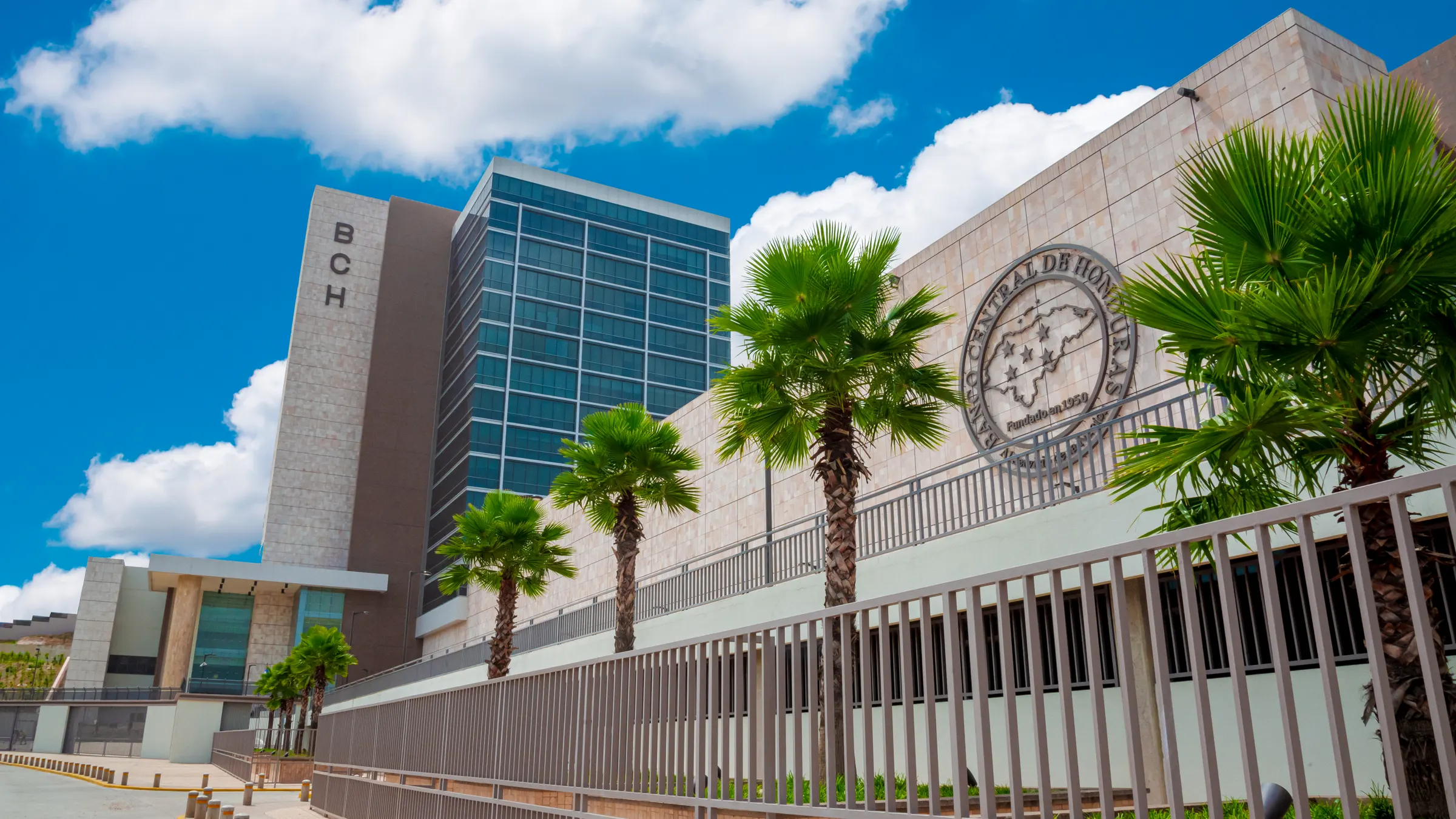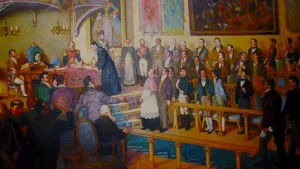Creation of the Central Bank of Honduras

The Central Bank of Honduras was created on February 3, 1950, by Legislative Decree No. 53, and began operations on July 1 of that same year, under the ownership of Attorney Roberto Ramírez, in an inauguration ceremony presided over by by Doctor Juan Manuel Gàlvez, President of the Republic.

History
From the series of events of a political, economic and social nature, three important events marked the beginning of a new stage in the country’s economic development process:
- The establishment of the Liberal Reform,
- The creation of our monetary unit, the Lempira, on April 3, 1926 and put into circulation in the 1930s and
- The foundation of the Central Bank of Honduras on July 1, 1950, which gave rise to the nationalization of means of payment and the reorientation of the monetary, exchange rate, and credit policy of Honduras.
At that time, when there were only two banks (Banco Atlántida and Banco de Occidente) that partially covered the financial activities of Tegucigalpa, San Pedro Sula and La Ceiba; In addition, although the National Congress had already approved the Lempira as the official currency, the Government had not been able to institute it as a monetary standard, until the founding of the BCH.
This is how the 1950 Law was the primary basis for the BCH to become a pillar of the Honduran economy.
Learn more about the Honduran Financial System
In Article 26 of the Law of the Central Bank of Honduras, it is established that: «The Central Bank will be the only issuer of coins and bills of legal tender, in the territory of the country, and for this it will be governed by said law and by the regulations issued by the Board of Directors on this matter and approved by the Executive Power.
The bills and coins issued by the Central Bank will have legal force and unlimited release power in the territory of the Republic.
Persons or entities that circulate objects or documents in order to serve as conventional currency, will incur the penalties established by the Penal Code for cases of counterfeiting.»
In its article 27 it says that: «The banknotes will have the denominations, drawings, legends and other characteristics indicated by the Bank’s Board of Directors and will bear the facsimile signature of the President and the Manager of the Central Bank and the Secretary of State in the Office of Finances (Treasury and Public Credit) and are printed in the amounts authorized by the Board of Directors itself.The denomination will not be less than one Lempira.
The metallic coins will have the weight, type, grade, size, engravings and denominations indicated by the special laws issued by the National Congress and will be issued in the amounts determined by the Directory».
BCH functions
- Formulate and direct the country’s Monetary, Credit and Exchange Policy and issue the corresponding regulations.
- Issue coins and banknotes that are legal tender in the territory of the country.
- Enabling exchange agents that will be able to negotiate currencies in the national territory.
- Manage International Monetary Reserves.
- Determine the currency exchange rate based on supply and demand.
- Carry out credit operations to address liquidity insufficiencies of the Institutions of the National Financial System.
- Carry out Monetary Stabilization operations.
- Exercise the functions of banker, fiscal agent and economic-financial adviser to the State.
- Prepare and publish the main macroeconomic statistics.
Senior Administration of the Central Bank of Honduras
The Board of Directors is made up of five (5) directors appointed by the President of the Republic through the Secretary of State in the Office of Finance, one of whom serves as President of the Institution and another as its Vice President.
Current BCH Directors
- Lic. Wilfredo Rafael Cerrato Rodríguez (President)
- Lic. Carlos Enrique Espinoza Tejeda (Vice President)
- Lawyer Catherine Yamileth Chang Carias (Director)
Among its main attributions are:
- Formulate and direct the country’s monetary, credit and exchange policy.
- Ensure the proper functioning and stability of the country’s financial and payment systems.
- Approve the annual monetary program, review and evaluate it every three (3) months at least.
- Authorize temporary credits for illiquidity to the institutions of the National Financial System.
- Issuing the rules, general conditions and limits for carrying out Bank operations.
- Issuing, with strict adherence to the law, the regulations that are necessary for the operation of the bank.

Lempira Monetary System
Lempira, was an indigenous hero of Maya-Lenca origin, who fought against the Spanish in defense of the freedom and culture of his people. In honor of this national hero and with the purpose of establishing the uniformity of the monetary system of Honduras, the government of the Republic through Legislative Decree No. 102 of April 3, 1926, adopted the «Lempira» as the monetary unit.</p >
In accordance with said Decree and its amendments, the Executive Branch was empowered to mint the following coins:
Table of coinage in Honduras in 1926
| Denomination in Lempiras | Weight (Crs.) | 0 (mm) | Metals |
|---|---|---|---|
| 20.00 | 16.71812 | 27 | 900 thousandths of fine gold |
| 10.00 | 8.35906 | 22 | 900 thousandths of fine gold |
| 1.00 | 12.50 | 31 | Silver of 900 thousandths of fine |
| 0.50 | 6.25 | 24 | Silver of 900 thousandths of fine |
| 0.20 | 2.50 | 18 | Silver of 900 thousandths of fine |
| 0.10 | 7.00 | 26 | 75% Copper and 25% Nickel |
| 0.05 | 5.00 | 21 | 75% Copper and 25% Nickel |
| 0.02 | 3.00 | 20 | 95% Copper and 5% Tin and Zinc |
| 0.01 | 2.00 | 15 | 95% Copper and 5% Tin and Zinc |
Likewise, based on said decree, in 1931 coins of 5, 20, 50 cents and One Lempira were put into circulation. The following year those of 10 cents circulated, in the year 1935 those of 1 cent and finally in the year 1939, those of 2 cents. No minting of the gold coins was made, despite having been considered within the structure of the new monetary system called «LEMPIRA».
Currently, the Central Bank issues banknotes in the following denominations: One, Two, Five, Ten, Twenty, Fifty, One Hundred and Five Hundred Lempiras.
In accordance with the current Monetary Law (Decree No. 51 of January 31, 1950 and its reforms) and depending on the price of metals, the Central Bank of Honduras is empowered to mint coins with the following specifications:
Table of coinage in Honduras in 1950
| Denomination in Lempiras | Weight (Crs.) | 0 (mm) | Metals |
|---|---|---|---|
| 1.00 | 12.50 12.50 |
31 | Silver of 900 thousandths of fine |
| 0.50 | 6.25 5.67 5.00 |
24 | Silver of 900 thousandths of fine 75% Copper and 25% Nickel 90% Steel and 10% Nickel |
| 0.20 | 2.50 2.27 2.00 |
18 | Silver of 900 thousandths of fine 75% Copper and 25% Nickel 90% Steel and 10% Nickel |
| 0.10 | 7.00 6.00 |
26 | 75% Copper and 25% Nickel 70% Copper and 30% Zinc 70% Copper and 30% Zinc |
| 0.05 | 5.00 3.20 |
21 | 75% Copper and 25% Nickel 70% Copper and 30% Zinc 70% Copper and 30% Zinc |
| 0.02 | 3.00 2.70 |
21 | 95% Copper and 5% Tin and Zinc 90% Steel and 10% Copper |
| 0.01 | 1.50 1.35 |
16 | 95% Copper and 5% Tin and Zinc 90% Steel and 10% Copper |
It is important to mention that the One Lempira, Fifty and Twenty Centavos coins were minted in silver for the last time in the years 1937, 1951 and 1958, respectively; At present, only Fifty and Twenty Cent coins continue to be issued, but with a different alloy than silver.
Commemorative Coins and Medals
The Central Bank of Honduras presents its brilliant collection of commemorative coins and medals (in Gold and Silver), alluding to some of the most important events and personalities in national life.
A priceless collector’s item or a fine and elegant gift, acquire your collection and be part of this just tribute.
You can purchase them at the Main Office in Tegucigalpa or at Branches in the main cities of the Country.
Bibliography
- Rigoberto Rojas Numismatic Museum
- History of the Currency in Honduras
- Central Bank of Honduras



